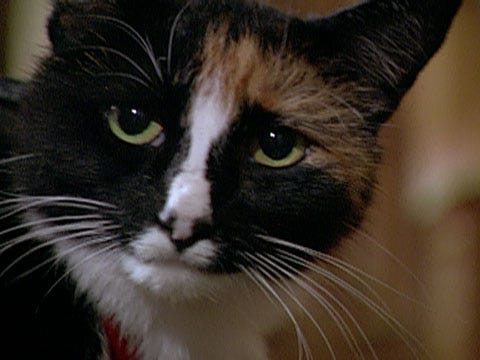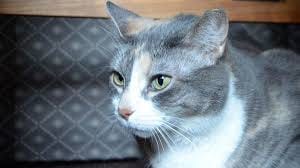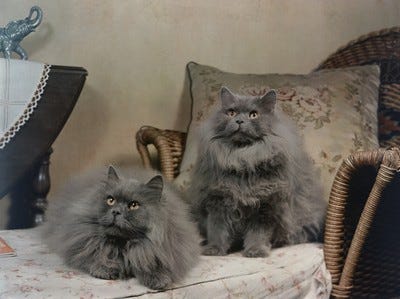A Conversation with Cat Geneticist Dr. Leslie Lyons
Lyons Discusses Her Research at the University of Missouri's College of Veterinary Medicine
By Jordan Schaul | National Geographic | October 23, 2013
Dr. Leslie Lyons is a world-famous cat geneticist. So you might surmise that she studies inheritable diseases in cat lineages or hereditary traits expressed in different cat breeds like coat color. Well, she and her students, staff, and colleagues study both health conditions and coat color because the same mutations that have influence over genetic disorders also influence physical appearance.
Dr. Lyon’s laboratory, which was popularly known as the “Lyon’s Den” at UC Davis recently relocated to the University of Missouri, College of Veterinary Medicine in Columbia to continue groundbreaking research in feline genetics. It may also have been renamed the “Tiger’s Lair” after the school’s mascot?
Interview:
Jordan: Did you really rename your laboratory?
Dr. Lyons: Not really no. This was a fun play on words. My father sometimes played around and answered the phone by saying “Lyons Den” – so I adapted for a fun name for the lab. People remember it. Then, we moved to the University of Missouri, their mascot is Truman the Tiger. Thus, the article that announced our arrival was entitled “Lyons’ Den enters the Tiger’s Lair”!
We call ourselves the Feline Genetics Laboratory.
Jordan: Can you tell us a bit about your background?
Dr. Lyons: I was born and raised in Uniontown, Pennsylvania – hence a big sports fan – Pirates, Steelers, and Penguins. I went to Uniontown High School and then to the University of Pittsburgh for a bachelor of science degree in Biochemistry. I was working in a genetics laboratory in the Graduate School of Public Health at the University of Pittsburgh, so continued on to get my master’s degree and doctorate degree in Human Genetics. I started my post-doctoral career in comparative genetics at the National Cancer Institute, the then Laboratory of Viral Carcinogenesis, which was later renamed the Laboratory of Genomic Diversity. At the NCI, I became involved with cats and have never looked back. I was recruited to the University of California – Davis in 1999 and now in 2013 to the University of Missouri – Columbia as the Gilbreath McLorn Endowed Professor of Comparative Medicine.
Jordan: Our genetic code is comprised of sequences of nucleotides of DNA or RNA. Any alterations in these sequences are what we refer to as mutations. Mutations are not only responsible for diseases that manifest in people and animals, but they also influence phenotypes— our physical appearance. So it is no surprise that Dr. Lyon’s feline genetics lab is not only known for developing DNA tests for insidious feline diseases, but for understanding the inheritance of coat color in cats.
So, which came first? I imagine there is more funding available for examining feline models of human diseases or at least studying cat diseases for the benefit of these popular companion animals than there is for the study of coat color?
Dr. Lyons: Coat color and disease studies really all go hand in hand as often a gene that controls a simple coat color in cats, may have a slightly different mutation in humans and cause a more devastating disease. We found this recently by identifying the gene that causes the Cornish Rex hair coat –- the same gene causes atrichia (no hair) and severe dental abnormalities in humans. The first mutations identified in cats were for diseases that are also found in humans – childhood diseases, such as Duchene muscular dystrophy, gangliosidosis, and mucopolysaccharidosis.
When we study traits that affect appearance, we are not always just studying a coat color or coat type, but the mechanisms as to how that gene functions, which happens to cause a coat color or fur type in cats. The gene that causes black in cats’ coats, for example, Agouti (Agouti-signaling protein, ASIP), can cause obesity in mice! The Tabby gene causes the classic – blotched pattern on cats – but this is really more interesting as to how this gene makes cells communicate and migrate in relationship to one another. But, overall, the goal is to improve human and cat health and to study genes that are related to diseases!
Jordan: You are definitely a cat lover. I’m a “latent felinophile.” But we both have an affinity for black cats. You, in fact, own a black cat. Can you explain a bit about cat coat genetics and melanism in particular? Perhaps in doing so you can help dismiss this notion that black cats are witches incarnate?
Dr. Lyons: The only difference between a brown tabby cat and a black cat is 2 nucleotides of DNA missing in the gene sequence for Agouti in the black cat. They must be homozygous, having 2 copies of the deletion, to be black. Black cats still even have their stripes but now they blend in with the background fur color! In domestic cats, melanism is recessive, in wild felids, such as Jaguars, different genes cause black. The gene, melanocortin receptor-1 (MCR1) has a mutation that acts in a dominant fashion, thus only one copy is needed, and the cats are black. Like domestics, the wild felids also still have their spots.
“You need a lot more genetic change to turn a human (witch) into a black cat, maybe a 20% difference, so, this minor change within a cat is really insignificant to make a brown tabby black.” – Dr. Lyons
Jordan: What are some of the achievements of your laboratory that you are most proud of and would like to share with us?
Dr. Lyons: One of our first major achievements in the laboratory was the identification of the mutation for polycystic kidney disease (PKD) in the Persian family of cats. Approximately 30% of Persians around the world at the time had PKD and the most popular group of cats by far is the Persian grouping of cats (Persians, Exotic Shorthairs, Selkirk Rex, Scottish Fold, and British Shorthairs). These cats all have PKD caused by one mutation. PKD is also one of the most common inherited diseases in humans too! But, most families of PKD patients have their own mutation, thus many PKD mutations are known, even some caused by different genes. The cat is a significant model for this disease to develop gene and drug therapies – which do not exist in humans.
Other cool things – we were involved with proving the first cloned cat, CC, was a true clone. Also for the first cloned wildcat, Ditteaux, and the first green fluorescent protein (GFP) cats. We have shown that the site for cat domestication is very likely the Near East and that the present-day cats of Egypt are likely descendants of the cats of the Pharaohs – the first to study mtDNA in cat mummies. We have found the mutations for thirteen coat colors and fur traits and nine different disease traits.
Jordan: Recently, I’ve researched some cat breeds and found that some breeders have produced some very bizarre animals. Some might call these feline creations very cute and some might say they are a bit bizarre-looking. Nonetheless, they all deserve a loving home. What are your thoughts on novel cat breeds, especially at a time when many non-pedigree individuals are in need of rescue?
Dr. Lyons: Yes, all cats deserve an appropriate home. Many non-pedigreed cats are in need of rescue, but pedigreed cats are more likely to stay in homes and also get very good health care. They also can provide a predictable behavior that may be more appropriate for a given family. Pedigreed cats are a very small proportion of the overall cat population, and novel cats are a cottage industry. The impact of novel breeds is minuscule as compared to promoting local spay/neuter/release programs and for cat owners to be responsible and alter their cats.
(All photos belong to National Geographic)
ABOUT NATIONAL GEOGRAPHIC SOCIETY
The National Geographic Society is a global nonprofit organization that uses the power of science, exploration, education, and storytelling to illuminate and protect the wonder of our world. Since 1888, National Geographic has pushed the boundaries of exploration, investing in bold people and transformative ideas, providing more than 14,000 grants for work across all seven continents, reaching 3 million students each year through education offerings, and engaging audiences around the globe through signature experiences, stories, and content. To learn more, visit www.nationalgeographic.org or follow us on Instagram, Twitter, and Facebook.
MEET THE AUTHOR
Jordan Carlton Schaul With training in wildlife ecology, conservation medicine, and comparative psychology, Dr. Schaul's contributions to Nat Geo Voices have covered a range of environmental and social topics. He draws particular attention to the plight of imperiled species highlighting issues at the juncture or nexus of sorta situ wildlife conservation and applied animal welfare. Sorta situ conservation practices are comprised of scientific management and stewardship of animal populations ex-situ (in captivity / 'in human care') and in situ (free-ranging / 'in nature'). He also has a background in behavior management and training of companion animals and captive wildlife, as well as conservation marketing and digital publicity. Jordan has shared interviews with colleagues and public figures, as well as editorial news content. In addition, he has posted narratives describing his own work, which include the following examples: • Restoration of wood bison to the Interior of Alaska while (While Animal Curator at Alaska Wildlife Conservation Center and courtesy professor at the University of Alaska) • Rehabilitation of orphaned sloth bears exploited for tourists in South Asia (While executive consultant 'in-residence' at the Agra Bear Rescue Center managed by Wildlife SOS) • Censusing small wild cat (e.g. ocelot and margay) populations in the montane cloud forests of Costa Rica for popular publications with 'The Cat Whisperer' Mieshelle Nagelschneider • Evaluating the impact of ecotourism on marine mammal population stability and welfare off the coast of Mexico's Sea of Cortez (With Boston University's marine science program) Jordan was a director on boards of non-profit wildlife conservation organizations serving nations in Africa, North and South America and Southeast Asia. He is also a consultant to a human-wildlife conflict mitigation organization in the Pacific Northwest. Following animal curatorships in Alaska and California, he served as a charter board member of a zoo advocacy and outreach organization and later as its executive director. Jordan was a member of the Communication and Education Commission of the International Union for the Conservation of Nature (CEC-IUCN) and the Bear Specialist Group of the IUCN Species Survival Commission (BSG-SSC-IUCN). He has served on the advisory council of the National Wildlife Humane Society and in service to the Bear Taxon Advisory Group of the Association of Zoos and Aquariums (AZA Bear TAG). In addition, he was an ex officio member of the council of the International Association for Bear Research and Management. Contact Email: jordan@jordanschaul.com http://www.facebook.com/jordan.schaul https://www.linkedin.com/in/jordanschaul/ www.jordanschaul.com www.bicoastalreputationmanagement.com





